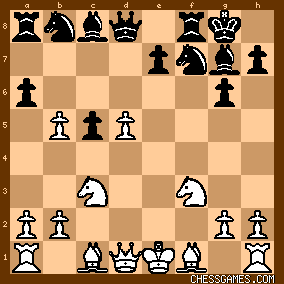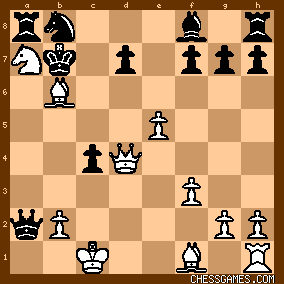|
< Earlier Kibitzing · PAGE 4 OF 5 ·
Later Kibitzing> |
Dec-08-05
 | | Sneaky: Well I did say it was risky (8.e5!?) but in your case I think I'd be fine: 10...Ne5 11.exf7+ Nxf7 12.Nf3 O-O 
click for larger viewWhite has the move in hand and much nicer pawns. It would take great care to consolidate this position, but nevertheless, you have to prefer White. When Black sets out to gambit a pawn in the Benko this is not the kind of position they hope for! |
|
| Dec-08-05 | | KingG: <When Black sets out to gambit a pawn in the Benko this is not the kind of position they hope for!> That's true, although i personally wouldn't mind being Black in this position. |
|
Dec-08-05
 | | Sneaky: A good tactician should find plenty to work with from either side of the board. I just checked it with my computer, it says that White is more than a pawn to the good, but I think in practice the player who is more alert will win. I've gotten into lines very similar to this (not your 10...Ne5 move, but 9...Ng4) against stronger players who totally take me apart, but other times I've had quaint little miniatures like the one I posted. The reason why I play this way against the Benko, incidentally, is because I have enormous respect for the opening. I find that playing the White side of the mainline Benko is pure torture. As shakey as this approach is, it's the one way I've found to force the Benko players to play my game instead of vice-versa. |
|
| Dec-08-05 | | KingG: The line Ne5 11.exf7+ Nxf7 12.Nf3 0–0 13.Be2 axb5 14.Bxb5 Qb6 15.Be2 c4 16.Bxc4 Qc5 17.Bb3 Ne5
looks quite promising for Black.
I agree with you though that at least it forces Black to play a game he might not like. Although since Ivanchuk plays the Benko, it goes to show that you can't stereotype Benko players too easily. |
|
| Dec-09-05 | | who: <KingG> I think you're right. If Sneaky were to play Ivanchuk with white - he'd still probably lose. |
|
| Dec-09-05 | | KingG: <If Sneaky were to play Ivanchuk with white - he'd still probably lose.> I think so too. :-) |
|
| Jan-26-06 | | Mate Hunter: Why does black plays 3...b5 (Benko Gambit) when black wins 29.8% vs white wins 42.8% (27.4% draws)? |
|
| Jan-26-06 | | unsound: Because it would be silly to base your opening repertoire on such statistics rather than aiming for positions you're comfortable with? |
|
| Feb-10-06 | | NBZ: these statistics should not be shown- as a way of judging the merits of an opening they are very unreliable |
|
| Mar-01-06 | | morphyvsfischer: <Sneaky> on 9...Ng4 in your line, 10 e6!? seems to pose some problems for Black, attackinbg the knight and forcing Black to play 10...Nh6 11 exf7+ Nxf7, which leads to your 10...Ne5 line. So 9...Ng4 isn't really anymore testing, or am I missing something? |
|
| Mar-01-06 | | morphyvsfischer: or 10...Ne5 |
|
| Apr-13-06 | | Bobak Zahmat: Unbelievable that a 10 year old girl's game can be a notable game! Truly fantastic. B Leverett vs Judit Polgar, 1987 |
|
| Apr-13-06 | | Shajmaty: <Mate Hunter>: "Why does black plays 3...b5 (Benko Gambit) when black wins 29.8% vs white wins 42.8% (27.4% draws)?" Why do U as White play 1. e4, then, which is a more-likely-to-loose opening than 1. d4, 1. c4 or 1. Nf3? Statistics have to be used wisely... |
|
| Apr-17-06 | | Bobak Zahmat: Statistics can be great help for developing your skills as a player, but you have to trust your own judgement about a certain opening or position. To discover your own weak points is the best way to learn how to play chess. |
|
| Jun-09-06 | | Akavall: I think I'll try this against Volga/Benko. |
|
| Jun-26-06 | | Kings Indian: I am now playing the Benko against 1.d4. Though the statistics are bad for black i think the Benko is very fun to play and full of tactics. Even in games with super long time controls i imagine it would be hard to play this as white. |
|
| Jun-26-06 | | midknightblue: <Kings Indian> I agree, but does this mean you will need to change your handle? |
|
| Jun-26-06 | | midknightblue: <Sneaky> thx for the interesting game. I found this game in the database which seems to be pertinent for how black should approach things after white plays Nc3 instead of bxa6. A Labarthe vs Jean Claude Moingt, 2002 |
|
| Aug-29-06 | | yanez: I prefer 5...g6 after 5.Nc3 but as white I like 5. f3 for a solid centre |
|
| Jan-13-07 | | whatthefat: In the last 2 rounds of the last tournament I went in, I had the rather strange experience of playing the f3 Benko as each colour, both times reaching the position after 1.d4 c5 2.d5 Nf6 3.c4 b5 4.cxb5 a6 5.f3 e6 6.e4 exd5 7.e5 Qe7 8.Qe2 Ng8 9.Nc3 Bb7. In the game I played as white, we followed theory to the 16th move! It later turned out we'd studied the same opening text. Unfortunately for me, I hadn't looked at it within the weeks before the tournament... The game continued:
10.Nh3 c4 11.Be3 Qb4 (11...axb5 12.0-0-0 Qb4 is more usual) 12.0-0-0 axb5 13.Nf4 Ne7 14.Qf2!? <<This avoids the deeply discussed queen sacrifice line: 14.Bb6 h5 15.Rxd5 Qxc3+!! 16.bxc3 Nxd5 with a very unclear game. White is probably objectively better, but it's easy for black to generate a dangerous attack on the black king. The classic example is B Lalic vs Khalifman, 1997;> 14...Qa5 15.Bb6 Qa6 16.Rxd5 (the rook can't be taken, otherwise a white knight will make it to c7) 16...Bc6 and to here we have been following Lim Chuin Hoong, Ronnie vs Wong Zi Jing, 2000 which continued 17.a3. I certainly considered the move, but I had to admit to myself that I couldn't remember any further, so I tried to look at the position completely afresh. This led to me playing the rather bizarre novelty 17.Rxb5?!? 
click for larger viewThe main idea being to free the d5 square for the knights. White gets some okay compensation, but not enough. Play continued 17...Bxb5 18.Nfd5 (Perhaps stronger would have been 18.Ne4) 18...Nxd5 19.Nxd5 Qxa2! (now I realised I was in some real trouble) 20.Nc7+ Kd8 21.Nxb5+ Kc8 22.Na7+ Kb7 23.Qd4 reaching this bizarre position: 
click for larger viewBoth sides are well behind in kingside development and have exposed kings, but it turns out white's is in more danger, and I should have been beaten fairly quickly from here. In the end I was lucky to struggle into an ending down a piece, but with an extra pawn and an initiative, and the game was eventually drawn. Moral: A rook sacrifice as a novelty should usually be avoided! |
|
| May-03-07 | | FICSwoodpusher: Does anyone here play the blumenfeld countergambit. I think there are some good ideas behind this opening in theory but often I don't get the best reults with it in practice. |
|
| May-03-07 | | Marmot PFL: White will have a statistical edge in any respectable opening. These stats are not bad for black but this is not an opening to play for a draw. Probably too risky for matches or strong round robins but fine for swisses. |
|
| Jun-15-07 | | WarmasterKron: <Sneaky> Re, bringing Benko players out of their comfort zone by playing away from the main line. I sometimes play the Benko, and I get around this potential problem by having little to no working knowledge of the main line. I prefer to be flexible in my ignorance. ;) |
|
| Aug-20-07 | | Edwin Meyer: Statistics aren't that bad for Black when you take a look at them in ChessBase's MegaBase 2007; 1-0 9373 =39% total:52%
1/2-1/2 6450 =27%
0-1 8281 =34% total:48%
So by all means, play the Benko if that's what you like ;-) |
|
| Nov-27-07 | | notyetagm: http://www.jeremysilman.com/chess_l... <BENKO GAMBIT, WHY YOU SHOULD PLAY …g6 BEFORE …Bxa6Mr. Ortner asks:
I usually don’t care to update the openings I play. That’s why my reference book for the Benko gambit is from 1991 (by Suetin). Recently, I came across a review of Neil McDonald’s new book THE BENKO GAMBIT REVEALED, where I read the following: “...he explains why you have to play g6 before taking on a6 with the
bishop.”
I don’t know McDonald’s book and wondered what’s wrong with taking on a6 with the bishop immediately. Moreover, my book doesn’t see anything wrong with the line 1.d4 Nf6 2.c4 c5 3.d5 b5 4.cxb5 a6 5.bxa6 Bxa6 either. Is there really something like a refutation of this line? Should I think about buying a new opening book for the Benko? Silman replies:
A lot of things change in theory in a very short time, but the need to get new books and keep up with those changes depends on the level of competition you face. If you’re a serious tournament competitor, you really should upgrade. If you just play for fun on-line or with friends, then there’s no reason to do so. The view that an immediate 5…Bxa6 is inaccurate has been generally accepted for a couple decades. However, this is based on the assessment of the following line: 1.d4 Nf6 2.c4 c5 3.d5 b5 4.cxb5 a6 5.bxa6 Bxa6 6.g3 d6 7.Bg2 g6 8.b3! Bg7 9.Bb2 0-0 10.Nh3 Nbd7 11.0-0 and though Black has tried just about every possible move and idea, White seems to come out on top. Because of this, 5…g6 became Black’s main choice. Now Black can meet 6.b3 Bg7 7.Bb2 0-0 8.g3 with 8…Nxa6 9.Bg2 Bb7 when Black is doing well due to the possibilities of …Nb4 and/or …e6. In a nutshell, you lose nothing by choosing 5…g6, since you can always hack off the pawn later by …Bxa6. Since there’s no downside, why not use this move, which keeps your options open and guards against the double fianachetto line mentioned above?> |
|
 |
 |
|
< Earlier Kibitzing · PAGE 4 OF 5 ·
Later Kibitzing> |





